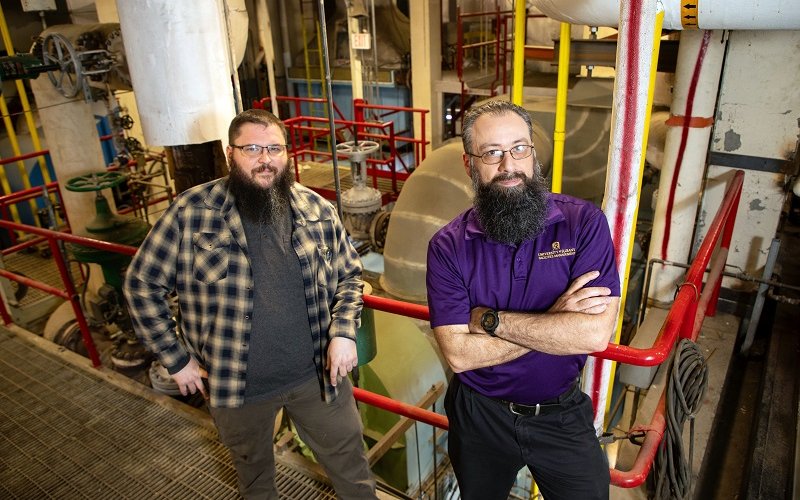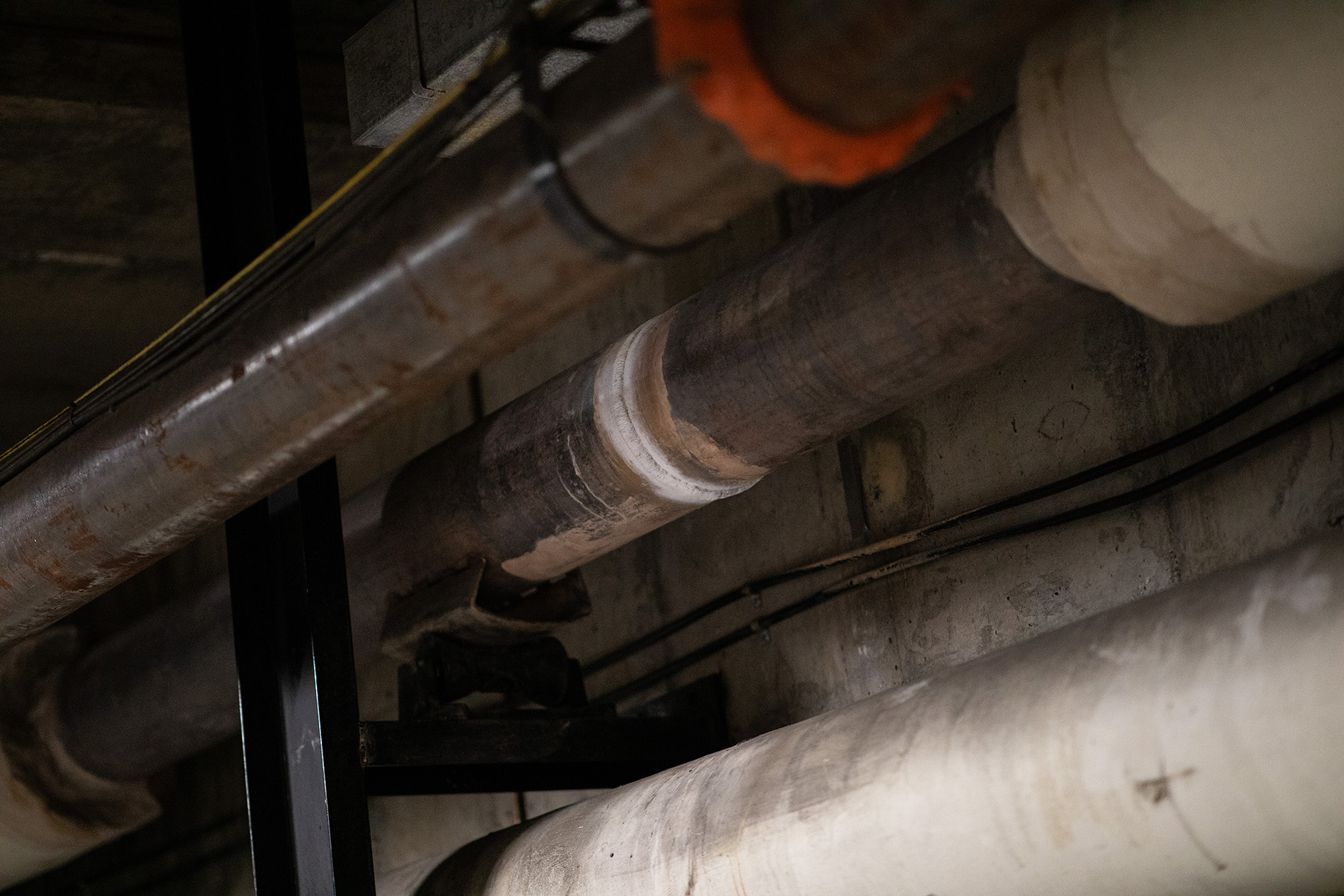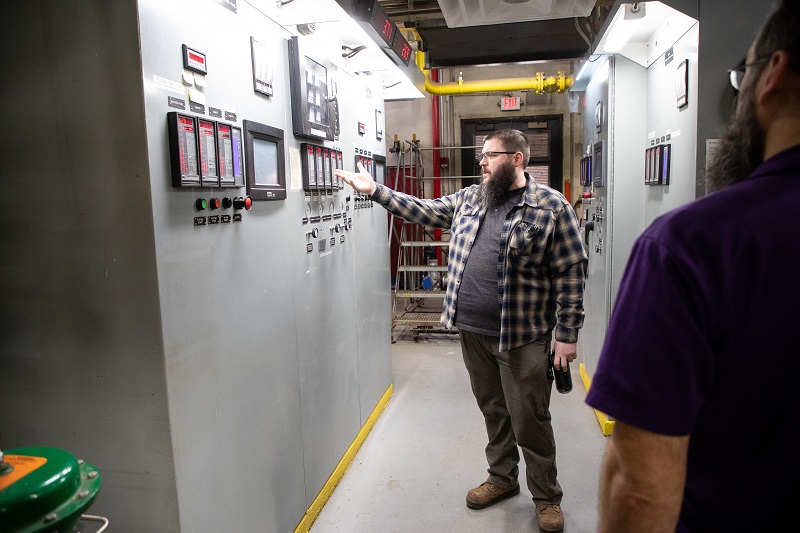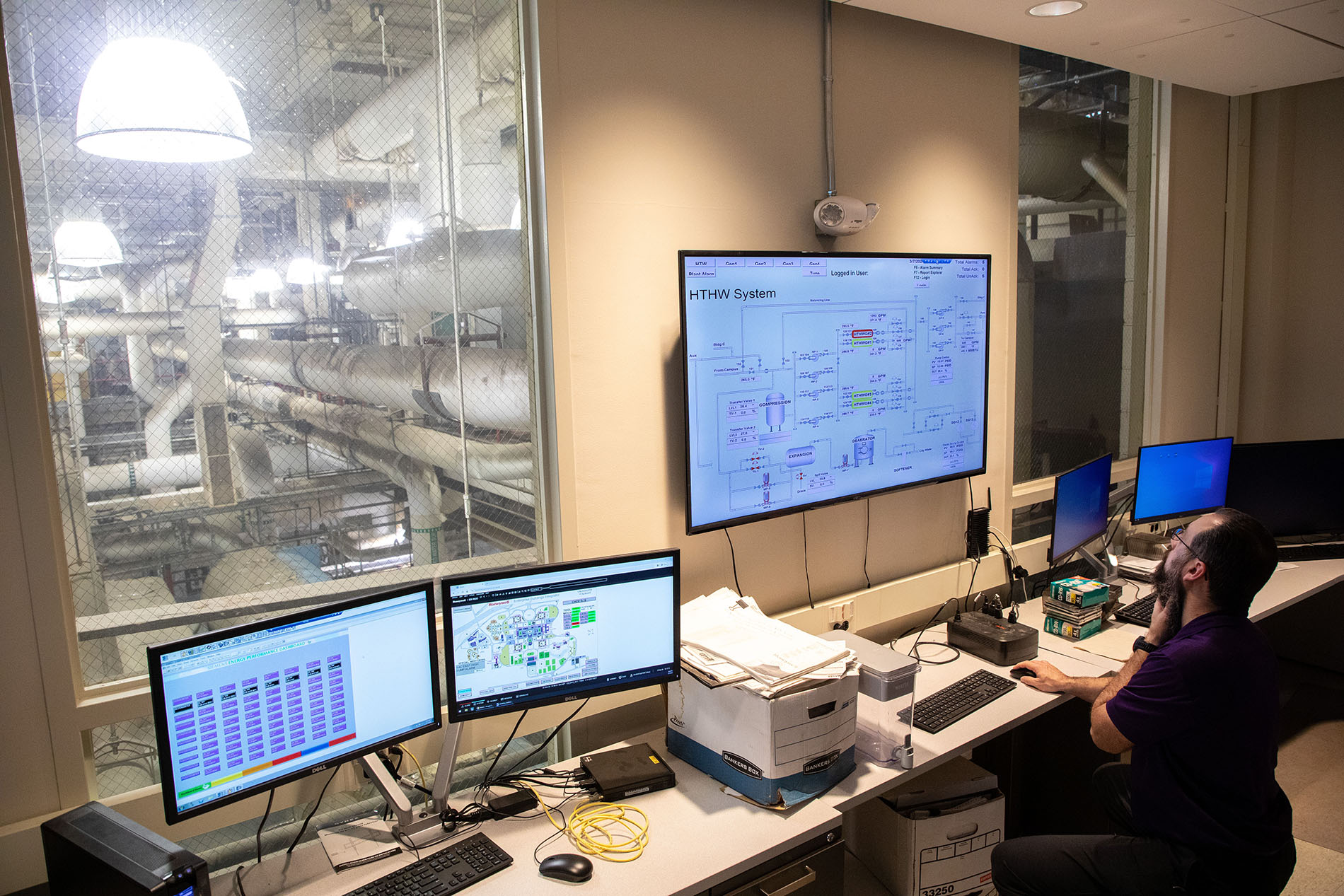Q&A: What it Takes to Keep the Heat Flowing on Campus

ALBANY, N.Y. (March 13, 2024) — When a cracked weld in a 10-inch high-temperature water line that feeds much of the Uptown Campus began leaking in the Podium tunnels recently, James Stalker got the call.
For most on campus, the crack meant an inconvenient interruption to heat and hot water service. For Stalker and his colleagues, it was another day in the life of those who mind the critical, but often invisible, services that keep UAlbany running.
Stalker, a Plant Utilities Engineer 3 who has worked at UAlbany for nearly 16 years, oversees UAlbany’s massive Central Heating and Cooling Plant — a round-the-clock, 365-day-a-year operation that relies on the skills and experience of more than 80 team members from the HVAC and Plant staffs to keep more than 6 million square feet of campus buildings comfortable.

About 30 of those staff work in the plant itself, just off Fuller Road, where four gas-fired high-temperature hot water boilers collectively pump out an average of 60-70 million BTU/hour. One BTU is the amount of heat required to raise the temperature of one pound of water by one degree Fahrenheit. That is, by any score, a lot of heat — enough by some measures to warm approximately 750 homes.
All that heat is delivered in the form of very, very hot water — superheated at high pressure (to as much as 385°F) and pumped through the vast network of pipes that comprise UAlbany’s circulatory system in the tunnels most of us use as shortcuts.
At that temperature and pressure, there are no small problems, and fixing them requires careful planning and the help of skilled colleagues and contractors.
Before his career with the University, Stalker studied HVAC/R and Plumbing at Capital Region BOCES in high school and earned two associate degrees from SUNY Delhi — one in plumbing, heating and welding and another in refrigeration, air conditioning, electrical construction and maintenance technologies. He had a job waiting for him at UAlbany as soon as he graduated.
The March 1 fix to the pipe near the Social Science and Humanities buildings required shutting the down the entire system — and with it, heat and hot water to much of the Uptown Campus — for about 22 hours as the weld was repaired.
We caught up with Stalker once the heat was back on to talk about what it takes to keep the system running in delicate balance, how the plant is incorporating more sustainable technologies and proper tunnel etiquette.
UAlbany’s heat and hot water system is not your average basement boiler, is it?

There are many differences, the most obvious being the size, controls and the burner. But the biggest differences that most people would be able to relate to are going to be the temperature and pressure at which we operate. Our system typically runs at 370°F at a pressure of 300-350 PSI and is capable of producing millions of BTUs of heat per hour. Your standard residential boiler, by comparison, is going to operate between 10-30 PSI and reach temperatures of up to 180°F, producing only tens or hundreds of thousands of BTUs.
Beyond that, we burn the same types of fuel as your household boiler (gas and oil), we are a forced recirculation system like your household boiler, and we even have something equivalent to zone valves like your household boiler. If you understand the fundamentals of combustion and HVAC, it’s still the same — it’s just much, much larger.
The biggest challenges with this system are its age (many parts of it date to the Uptown Campus’ construction in the 1960s) and finding enough qualified staff and vendors to operate and maintain it.
Are those high temperatures and pressures the reason you can't just turn it off and fix it right away?
That is correct. The most time-consuming part of the recent repair was shutting the system down and starting it back up again. Shutting down a system running so hot and at such high pressure is a slow and methodical practice. Our system’s operation is 100 percent reliant on the temperature and pressure relationship. As temperature rises, so does pressure, and the opposite is true as well. Normally, water boils at 212°F and turns to steam. When that happens, the water expands to more than 1,600 times its original volume. In order to keep the water in our pipes in a liquid state, we compress it with a bubble of nitrogen, raising the system’s pressure to greater than or equal to 300 PSI (compared to normal atmospheric pressure of about 14.7 PSI), which raises the boiling point of water to 417°F.
If we were to shut the system down and the leak caused the system to depressurize too fast before the water has a chance to cool, the water would begin to flash to steam and expand. That rapid expansion would be catastrophic for our system. The same holds true for start-up. If we were to start heating the system up at a pace that exceeded the rate of pressure increase, the water would flash to steam. The other consideration is expansion and contraction within the system. As the system heats, it expands, and as it cools, it contracts. Rapid expansion and contraction would put a tremendous amount of stress on our system and lead to future failures.
What's it like to know that the ability of thousands of people to take a hot shower is in your hands?
It’s a big responsibility to say the least, but I’m fortunate that I have a group of talented and motivated individuals that work here in the plant, as well as counterparts across campus who also have the same good fortune with their staff. It’s a lot of hard work and long hours, but we all make it work because we know people are relying on us.

The tunnels are your workspace. If you could get everybody on campus to follow one rule in the tunnels, what would it be?
Please be mindful of your surroundings. Stay off your phone, stay alert and stick to the designated walking path. When I was a building engineer, I once had a student who was so engaged in what was happening on her cell phone that she walked head on into my parked Cushman cart. The tunnels need to be treated as an active job site at all times — because they are.
Sustainable new technologies are changing how we heat and cool buildings. What will that mean for UAlbany’s Plant/HVAC system?
There is definitely a big push toward reduced energy consumption and a greater reliance on sustainable energy here on the campus. There are many tentative plans for the future of the plant, including replacing two of our high-temperature hot water absorption chillers with heat pumps with a geothermal well field, similar to the all-electric technology used to heat and cool ETEC. There have even been talks about building a satellite plant on a different part of the campus to house these units as the shift toward electrification progresses to reduce the amount of carbon used to heat and cool our facilities — even as cooling demand increases. We know that’s where we’re headed; what we’re working on now is the best path to get us there.
(According to UAlbany’s Office of Sustainability, the plans currently in development with the help state funding will allow the campus to reduce its annual natural gas usage by 16 percent.)
You’re responsible for massive, complex building systems at work. What’s one home repair you’re calling in an expert for?
My roof. I have no desire to do any work in, on or around my roof. I’m also not above calling someone in to brush down my boiler for me. The shoemaker’s children go barefoot, you know!




